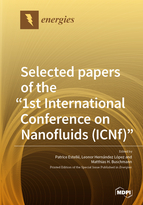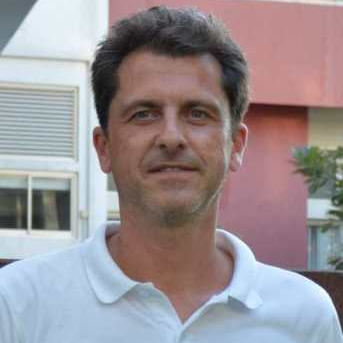Selected papers of the "1st International Conference on Nanofluids (ICNf)"
A special issue of Energies (ISSN 1996-1073). This special issue belongs to the section "J: Thermal Management".
Deadline for manuscript submissions: closed (30 November 2019) | Viewed by 29698
Special Issue Editors
Interests: nanofluids thermophysical properties; nanofluids heat and mass transfer; energy
Special Issues, Collections and Topics in MDPI journals
Interests: solar nanofluids; nanofluid characterisation; nanofluid solar absorption; heat transfer and storage properties
Special Issue Information
Dear Colleagues,
The 1st International Conference on Nanofluids (ICNf) coupled with the 2nd European Symposium on Nanofluids (ESNf) will be held on 26–28 June 2019 in Castellon, Spain. This scientific event is organized under the auspices of the European Cooperation in Science and Technology (COST) Action—NANOUPTAKE (CA15119, http://www.nanouptake.eu). This conference provides platforms for global collaboration and the exchange of knowledge between researchers and engineers working on nanofluids and related areas as well as applications in energy enhancement and systems, and it will give an overview of the current research findings, developments and achievements in these fields.
Details of these conferences are provided on the conference website, http://www.icnf2019.com.
Note that the deadline for conference abstract submission is 31 January 2019 and both informations and template can be found here
http://www.icnf2019.com/index.php/papers/paper-guidelines
Registration is available for you via:
http://www.icnf2019.com/index.php/registration/registrationen
The focuses of ICNf 2019 include the production and characterisation of nanofluids and liquid-based nanocomposites, nanofluid-based heat transfer and storage of thermal energy, as well as industrial applications. Representatives of related industries are invited to ICNf 2019 to enable direct knowledge transfer from science to industry. ICNf 2019 covers nanofluid aspects ranging in a wide field from basic research to real world energy industrial applications.
All accepted abstracts will be published in the conference proceedings. Authors are encouraged to send their work to Energies (IF 2.676) for a Special Issue publication. It is mandatory that the work should be presented in ICNf 2019 by one registered author. Original high-quality papers related to the conference topics are especially solicited and will be considered for publication.
Award(s) offered by scientific committee and conference organizer may be considered for the best papers and presentations to cover the Article Processing Charge (APC).
The topics to be covered at the conference and in this Special Issue include the following:
- Nanofluid materials (nanoparticles, nanoPCM, nanofluids, nanosalts, ionanofluids, etc.)
- Nanofluid preparation and characterization methods (stability, physical and chemical effects, agglomeration, etc.)
- Nanofluid properties (thermophysical, optical, and magnetic properties)
- Heating, cooling, and refrigeration
- Phase change-based heat transfer (boiling, surface coating, heat pipes, etc.)
- Storage of thermal energy
- Solar energy applications (specific black nanofluids, volumetric solar collectors, etc.)
- Numerical simulations on the microscopic and macroscopic levels
- Industrial applications
- Health, safety, and environmental issues
This publication is based upon work from COST Action Nanouptake, supported by COST (European Cooperation in Science and Technology). COST (European Cooperation in Science and Technology) is a funding agency for research and innovation networks. Our Actions help connect research initiatives across Europe and enable scientists to grow their ideas by sharing them with their peers. This boosts their research, career and innovation. www.cost.eu

Dr. Patrice Estellé
Prof. Leonor Hernandez
Dr. Matthias H. Buschmann
Guest Editors
Manuscript Submission Information
Manuscripts should be submitted online at www.mdpi.com by registering and logging in to this website. Once you are registered, click here to go to the submission form. Manuscripts can be submitted until the deadline. All submissions that pass pre-check are peer-reviewed. Accepted papers will be published continuously in the journal (as soon as accepted) and will be listed together on the special issue website. Research articles, review articles as well as short communications are invited. For planned papers, a title and short abstract (about 100 words) can be sent to the Editorial Office for announcement on this website.
Submitted manuscripts should not have been published previously, nor be under consideration for publication elsewhere (except conference proceedings papers). All manuscripts are thoroughly refereed through a single-blind peer-review process. A guide for authors and other relevant information for submission of manuscripts is available on the Instructions for Authors page. Energies is an international peer-reviewed open access semimonthly journal published by MDPI.
Please visit the Instructions for Authors page before submitting a manuscript. The Article Processing Charge (APC) for publication in this open access journal is 2600 CHF (Swiss Francs). Submitted papers should be well formatted and use good English. Authors may use MDPI's English editing service prior to publication or during author revisions.







